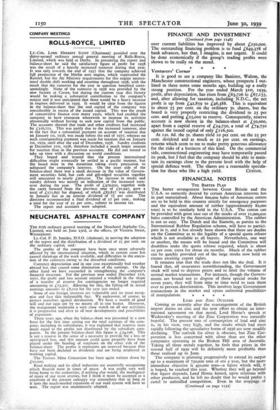AMALGAMATED ANTHRACITE RESULTS
The 1938 results of Amalgamated Anthracite Collieries are much as I expected. Trading profits, at £296,529, show virtually no change from 1937, net profit, after debenture and bank interest, &c., is £193,741, which covers funding certificate interest, taxation, &c., six months' depreciation, and with the balance brought in, enables £187,318 to be applied to the Assets Revaluation Deficiency Account in accordance with the terms of the capital reconstruction scheme. After this provision has been made, there is a credit balance to go forward of £63,587, but no dividend, of course, for share- holders. Still, everything has now been cleared up and the stage is set for a resumption of dividends in 1939. What are the prospects? They seem to be hopeful without being exciting. Trading profits, so far as one can judge from recent reports from South Wales, should be moderately higher this year. I will put them at £330,000, against the 1938 figure of just under £300,000. Deducting debenture and bank interest, &c., I arrive at a figure of £160,000. Then comes the question of depreciation. For six months the board has charged £40,000, which seems to me little enough on fixed and semi-fixed assets which, even on their written-down basis, are carried at some £6,000,000. I would rather raise the annual depreciation figure to £1 oo,000, which leaves £60,000 as an available balance for dividends. This roughly covers the 31 per cent. cumula- tive dividend on the reorganised preference capital. At the current price of 8s. 6d. these LI preferences are quite promising as a lock-up speculation. They should give a good yield and have participating rights up to a maximum dividend of 71,- per cent.
Perhaps the most impressive point in the 1938 accounts is the inclusion of consolidated balance-sheets for the past three years. Here is a company whose position it is impos- sible to assess v'ithout group figures, and the board has obliged with as neat a set of accounts as I have seen. Over the three-year period indebtedness in respect of debentures, notes, mortgages, bank advances, &c., has fallen by roughly £700,000 to £2,003,033, and the surplus of current assets
(Continued on page tiso)
FINANCE AND INVESTMENT (Continued from page 1148)
over current liabilities has improved by about £250,000. The outstanding financing problem is to fund £649,378 of bank advances, but that, I imagine, is not urgent. It could be done economically if the group's trading profits were shown to be really on the mend.











































 Previous page
Previous page